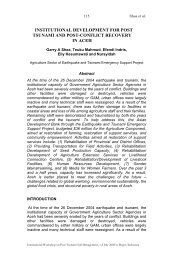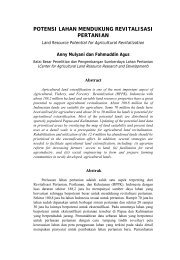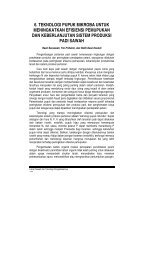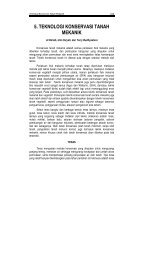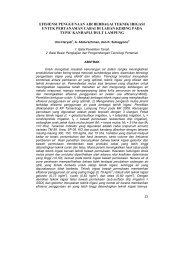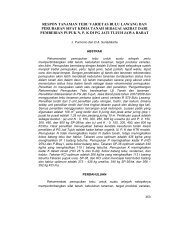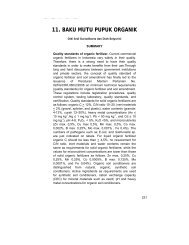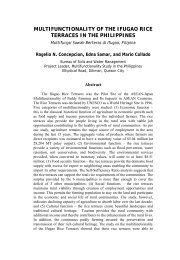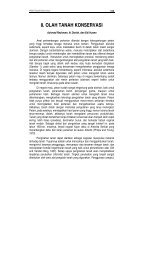Proceedings - Balai Penelitian Tanah
Proceedings - Balai Penelitian Tanah
Proceedings - Balai Penelitian Tanah
Create successful ePaper yourself
Turn your PDF publications into a flip-book with our unique Google optimized e-Paper software.
140<br />
Wahyunto et al.<br />
second layer of each representative profile were collected, and<br />
labeled. The number of soil samples collected were based on the<br />
variation of land units, soil and land use. Therefore, 206 soil samples<br />
and 13 water samples have been selected for laboratory analysis.<br />
The physiographic mapping unit descriptions contain a lot of<br />
parameters for land evaluation purposes, that can only be filled in at a<br />
later stage, after laboratory analyses of soil and water samples. Soil,<br />
climate and other physical environment data (slope, surface drainage<br />
etc) were used to assess land suitability levels of various agricultural<br />
commodities. Some parameters and ratings of land characteristics for<br />
evaluating certain crops suitability were modified based on field<br />
performance. Therefore, Physiographic Mapping Unit (PMU) is<br />
established in order to present the information of soil characteristic<br />
and its environment distribution that have similar potential<br />
development for agriculture. Soil mapping unit is based on the<br />
similarity of terrain, slope, soil surface texture, drainage, and organic<br />
layer thickness, and tidal or flood inundation.<br />
Land suitability evaluation for selected economic tree crops and other<br />
agricultural crops were conducted be by using Automated Land<br />
Evaluation System (ALES) software package. The crop requirements<br />
were based on “Guidelines for Land Evaluation” by ISRI (2003) and<br />
related references. Adaptation to the guidelines was made as<br />
necessary based on field and laboratory findings. The process of this<br />
evaluation is the matching of crop requirements against land qualities<br />
or characteristics. The law of minimum is applied to determine the<br />
limiting factors of land suitability classes. Selected land quality in this<br />
evaluation includes air temperature regimes, water availability, rooting<br />
condition, nutrient retention, availability of NPK nutrients, salinity and<br />
toxic elements. In this present study, four suitability classes are<br />
recognized including in the Order S Suitability, together with the<br />
following names and recommendations (class S1 highly suitable,<br />
class S2 Moderately suitable and class S3 Marginally suitable) and<br />
the Order N Not suitable.<br />
RESULTS AND DICUSSIONS<br />
General Physical Condition of Study Area<br />
Administratively Aceh Barat District consists of 11 sub-districts<br />
(kecamatan), 33 mukims and 314 villages with Meulaboh as the<br />
capital. There are coastal four sub-districts, Arongan Lambalek,<br />
Samatiga, Johan Pahlawan and Meurebo that contain approximately<br />
60% of the total population (Bappeda Kabupaten Aceh Barat, 2005).<br />
All the coastal sub-districts were affected by the tsunami, and the<br />
study focussed on these four districts.<br />
International Workshop on Post Tsunami Soil Management, 1-2 July 2008 in Bogor, Indonesia



